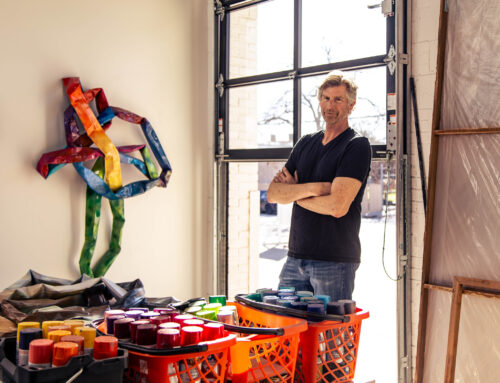If you follow the social scene in Dallas, or just read the local paper, you’ve probably heard of Sis Carr. Most people know her for her work with the performing arts, which she has been involved in for decades.
Sure, she has donated money to groups all over town. But she has given them even more of her time. The Dance Council, Dallas Theater Center, the Fort Worth Dallas Ballet and the Arts District Friends are just a few of the organizations she has helped found or lead.
In short, Carr is probably one of the best friends the Dallas performing arts have ever had.
But for all her good works, she also is known for something completely different. Sometimes referred to simply as “the yellow lady,” she’s famous for her love of the color yellow.
Stories about Sis Carr can leave those who hear them more than a little intrigued. Is it true she only wears yellow clothes and drives yellow cars? Did she really dye a mink coat yellow? And if all that’s true, what must her house be like?
Actually, not what you might expect. A ride to Carr’s Preston Hollow home takes visitors up her drive, through towering trees, surrounded by green. A narrow bridge crosses a small creek. The extensive grounds are impressive, especially with small lots in the area going for hundreds of thousands of dollars.
The house itself is of medium size and French Provincial style. A maid in yellow scrubs greets visitors at the door. In the living room are family photo albums, and the pictures inside show Carr was a beauty in her youth. Today, signs of that beauty are still evident when she speaks, smiling often and answering questions thoughtfully.
Much of Carr’s time these days is focused on helping the Fort Worth Dallas Ballet grow. Asked how long she plans to continue working with the ballet and other artistic groups, she says, “I will continue as long as I think I can do something to help. I first started working with the ballet back in the ‘60s, along with a lot of others. I’ve seen a lot of changes.”
Despite her high profile in Dallas, she is surprisingly accessible: friendly, intelligent and remarkably down to earth.
And these characteristics are reflected in her home. There are no marble columns or imposing statues to be found. The furniture actually looks like people sit in it. The rooms are not overwhelmed by yellow, although a soft yellow background is seen in the upholstery of the furniture and curtains. Otherwise, though, the color is seen mostly in accents: a single yellow flower, a yellow frame, yellow figurines here and there.
Carr and her husband, the late William Plack Carr, built the house in 1952. Through the years, she has made very few changes to its interior. She loved the décor when they built it, still loves it, and has never seen a reason to change it.
She tells of raising their three children in the home and how, 50 years later, it’s still a gathering place for a family that includes six grandchildren and ten great-grandchildren.
“We moved out to the country because our daughter really loved horses,” she says, referencing a time when our neighborhood was thought of as a rural area. “We originally had 20 acres, with a large pen out here. She could just ride her horse all over.”
And though things have changed drastically around them, the remaining eight acres surrounding the home still offer a sense of being in the country.
A tour of the grounds reveals a series of small gardens behind the house, many of which Carr designed herself, connected by a flagstone path.
“It’s a rustic garden,” she says. “It’s not overly manicured.”
The gardens feature a variety of figurines – some whimsical, offering a hint of Carr’s sense of humor, others meant to give a feeling of peace. Further from the house, the grounds have a feel of natural luxury, the shrubs and trees creating a sea of green. It’s as if everything were left as originally found, because it happened to be lovely. And there’s not a single sign of the city.
A closer look reveals several areas filled with smooth rocks, each painted the color that Carr loves best. And, scattered practically everywhere are daffodils, offering a bright yellow contrast to the foliage when in bloom. Carr got many of the bulbs from Joe Lambert, a prominent landscape architect in the 1950s and ‘60s. For years, he’d call her any time he found extra bulbs.
“They’re all over,” she says. “We just have thousands.”
Asked how she came to love the color yellow so much, she replies: “I really don’t have anything dramatic to say about it,” she says. “I’ve just loved it all my life.”
The simplicity of her response goes a long way in describing the way she’s lived her life. Carr is a woman who knows what she likes. She’s chosen a few specific things to love and has built her life around them: Her family, her home, the arts.
Knowing that, her devotion to the color yellow makes sense. And as her answer indicates, it’s just not that big a deal






